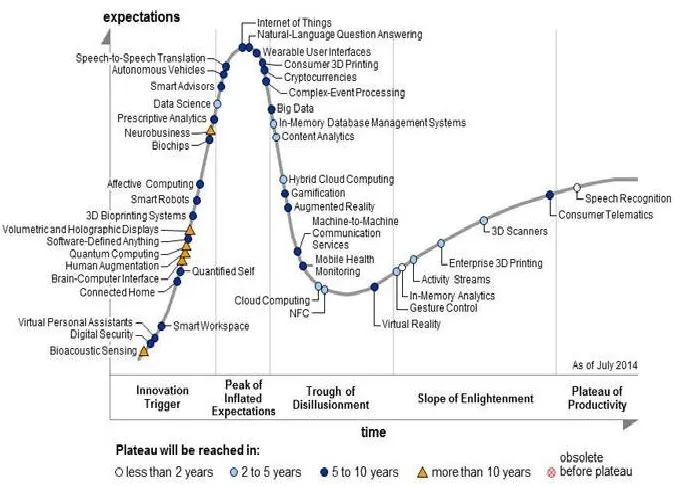From idea to implementation, Gartner Hype Cycle tracks evolution of technology innovation
From speech recognition to connected homes, society is witnessing a range of mature and emerging innovations. Research firm Gartner’s ‘hype cycle’ reports are good overviews of the broad sweep of technology as they go through the five phases of innovation trigger, peak of inflated expectations, trough of disillusionment, slope of enlightenment and plateau of productivity.

The 2014 Gartner Hype Cycle Report is based on analysis of over 2,000 technologies, services and trends in 119 areas. (See also my earlier reviews of research on innovation and entrepreneurship by WIPO, NVCA, Kaufmann Foundation, OECD and EY.)
Some innovations are considered transformational to business, others are high impact. Some accelerate at high rates, others move relatively slowly - depending on factors such as cost, rate of adoption and competing technologies.

Source: GartnerMobility and data
Mobile is rapidly becoming the primary vehicle for business applications. Internet of Things (IoT) and operational technologies (in the domain of the physical world) are a key component of the digital business opportunity, according to Gartner. The pervasiveness of devices among consumers and within enterprises and the increasing interest in mobile applications is driving mobile support. Emerging mobile infrastructure to watch are 5G wireless and heterogeneous networking.
IoT is becoming a vibrant part of the IT landscape, and business leaders should not ignore it because they may currently feel that their primary focus is only on ‘enterprise’ systems. On the analytics front, IoT and mobility will in turn drive more data into the enterprise, the report observes. Business analytics PaaS, the delivery of analytics capabilities and tools as a service, is nearing peak point on the cycle. Convergence of trends is driving some adoption curves even faster.
Interest in Big Data remains undiminished, according to the report, and new technologies and practices have emerged. Moving beyond the hype peak does not mean that interest has diminished, but that focus is more on actual implementations rather than expected impacts.
Cloud
Cloud computing, private cloud computing, and hybrid cloud have moved beyond the peak phase. Some of these have limitations due to their lack of maturity and the complexity of setting them up in operational form, the report cautions. Cloud service brokers are over the peak, reflecting interest in pragmatic implementations.
“Cloud is one of the most hyped terms in the history of IT,” according to the report. Gartner cautions business leaders against ‘cloud washing’ by vendors, who continue to jump on the cloud bandwagon with anything they can label ‘cloud.’ Many readers may even be experiencing ‘cloud fatigue’ due to media news on outages and to questions about security and privacy.
Social media

Implementation of social network analysis has revealed the difficulty of collecting relevant, reliable networking data. Social gaming, socialcasting and social TV are in the trough phase.
The digital edge
Digital business approaches such as dashboards are moving beyond trigger stages. They are used to aggregate and integrate payment methods and loyalty programs into a single platform for example.
Gartner also draws attention to infonomics - the valuation, accounting, treatment and reporting of information as a core asset of the business – which is now at trigger ‘midpoint’ position. This reflects the value of reputation information in a digital currency world, similar to the value of money itself.
Other tools and technologies worth watching are external peer-to-peer communities (virtual collaboration spaces outside the enterprise) and social procurement tools (procurement channels with capabilities such as those of social websites). Retail 3D printing is at trigger midpoint, driven by customer desire for personalised and customised products, services and shopping experiences.
Business implications
Gartner's earlier 2013 CEO survey revealed that 57% of respondents report having a digital strategy that is either integral to or aligned with their business strategy, at varying degrees of implementation for enterprise architecture and digital workplace.
“By 2016, use of cloud and social will be so pervasive that 60% of organizations will not consider them as a significant factor, in and of themselves, when making investment decisions. Use of cloud and social will be the expected norm, but not a differentiated factor in themselves,” Gartner predicts.
Among mature technologies are Web-oriented architecture and software as a service. An interesting finding of the report is that even business models of the Internet and e-business eras have begun to be disrupted by the advent of new waves of digitalisation.
Gartner predicts that smart machines will constitute one of the most disruptive eras of technology innovation. “Smart machines are an emerging super-class of technologies that can perform a wide variety of tasks,” the report explains.
As a healthcare trend, the report highlights the more active role consumers are taking in healthcare, and the blurring and interwoven role that healthcare organisations are playing in consumer engagement and telemedicine.
Further reading into the report reveals lessons for CTOs, CIOs, CMOs and COOs. For example, companies will need to have dual-speed or bimodal operations that blend legacy IT along with new innovative technologies. One of the top priorities for a CIO is dealing with consumerisation of IT, employee agility, and rapid increase of smartphone and tablet adoption.
In sum, the Gartner report gives a sense of perspective on technology evolution and how business leaders and innovators should be drawing up their strategy radar, and which competitive position to be adopting.







